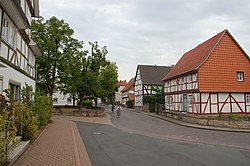Jestädt
| Jestädt | |
|---|---|
| Ortsteil of Meinhard | |

Village green (left) and the oldest timber house in the region (right)
|
|
| Coordinates: 51°01′N 10°10′E / 51.017°N 10.167°ECoordinates: 51°01′N 10°10′E / 51.017°N 10.167°E | |
| Country | Germany |
| State | Hesse |
| District | Werra-Meißner-Kreis |
| Municipality | Meinhard |
| Government | |
| • Mayor | Gerhold Brill |
| Area | |
| • Total | 19.61 km2 (7.57 sq mi) |
| Elevation | 163 m (535 ft) |
| Population (1971-12-31) | |
| • Total | 990 |
| • Density | 50/km2 (130/sq mi) |
| Time zone | CET/CEST (UTC+1/+2) |
| Postal codes | 37276 |
| Dialling codes | 05651 |
| Vehicle registration | ESW |
| Website | www.meinhard-jestaedt.de |
Jestädt is a borough of the Municipality (German: Gemeinde) of Meinhard in the Werra-Meißner-Kreis in the State of Hesse of Germany.
Jestädt lies at the far southwestern foothills of the Gobert mountain range in the Werratal — the valley of the Werra River in the Kaufungen Forest – and on the north side of the Werra River, 2.7 miles ( 4.5 kilometers ) northwest of Eschwege. This river flows south of Jestädt. The Mühlbach [ "Mill Brook" ] runs through the middle of the village to one side of the Werra and the Wehre River empties into the other side in the west-south-west of the village. The neighboring places are Motzenrode in the north, Neuerode in the northeast, Grebendorf in the southeast, Niederhone in the south and Albungen in the northwest. Two main roads running through Jestädt are the Landesstraße [ State Route ] 3403 and the Kreisstraße [ District Route ] 3.
Mentioned for the first time in the records in 876, Jestädt is one of the oldest settlements in the ancient district of Eschwege. It was originally built as a fortified village to defend a Ford across the Werra River.
The village's name, according to Professor Theodor Haas of Fulda, is composed of two words. One of them is an adjective, either gahi from Old High German or gaehe or gah from Middle High German, both meaning "sudden" and "suddenly", with the connotation of "steep slope". The other is the word Stätte, the German word for "place". Gahesteti or Jestaedt therefore means a place on a steep slope, which describes the actual location of Jestädt today. It was spelled as "Gestede" in 1324 and "Jestade" in 1414 but its present spelling did not come until 1664.
...
Wikipedia

